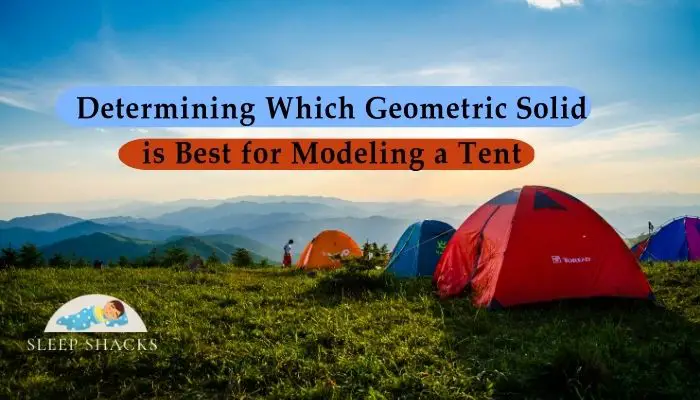usa, uk
Geometric solids are essential for modeling objects in various fields, including architecture, engineering, and design. When it comes to sporting a tent, there are several geometric solids to choose from, each with unique characteristics. When choosing a geometric solid to model a tent, it’s important to consider the shape, size and intended use of the tent. Commonly used solids for tent modeling include cones and cylinders, as they closely resemble the shape of a tent.
In this article, we will explore the features of different geometric solids and determine which is best suited for modeling a tent.
Which Geometric Solids would Model the Tent?
When modeling a tent using geometric solids, there are several options. The most common geometric solids used for this purpose are the cylinder, the cone, and the pyramid. A cylinder is an ideal choice if the tent has a circular base, as it perfectly represents the shape of the tent.
A cone would be best suited for a tent with a pointed roof, as it would mimic the sloping shape of the roof. Conversely, a pyramid would help model a tent with a triangular base. However, it’s essential to remember that the geometric solid’s size and proportions should match that of the tent to ensure an accurate representation.
Characteristics of Geometric Solids that can Model a Tent
A tent is a three-dimensional structure typically supported by poles or other supports. It has a shape similar to a cone or a cylinder and is covered with a material such as canvas or nylon. Therefore, a geometric solid that can model a tent should have a similar shape to a cone or a cylinder.
A cone is a geometric solid with circular base that tapers to a point at the top. It is similar in shape to a tent, which tapers to an end at the top. A cylinder has a straight vertical side and a circular base.
Determining Which Geometric Solid is Best for Modeling a Tent

We need to think about a few things to choose the right geometric solid for modeling a tent. These include the tent’s size and shape, what material will cover the tent, and why we need the tent. For example, a camping tent might need a different solid than a tent for a party or event.
If the tent is tall and narrow, a cone may be the best geometric solid to model it. A cylinder may be better if the tent is shorter and wider. The material used to cover the tent can affect the choice of the geometric solid. A tent with flexible and stretchy material may require a different geometric solid than a stiff and rigid one.
Difference Between a Cylinder and a Cone when Modeling a tent
As mentioned earlier, a cylinder and a cone are two geometric solids that can be used to model a tent. While they have some similarities, they also have some differences that can affect the choice of the geometric solid. The primary difference between a cylinder and a cone is its shape.
A cylinder has a straight vertical side and a circular base. This shape can be proper when modeling a wider and flatter tent, with less of a taper towards the top. On the other hand, a cone has a circular base that tapers to a point at the top. This shape can be proper when modeling a taller and narrower tent, with more of a taper towards the top.
Can a Rectangular Prism be Used to Model a Tent?

A rectangular prism is another geometric solid that can model objects. However, there may be better options for modeling a tent. Six rectangle-shaped faces make up a rectangular prism. This shape is not similar to a tent, which has a circular base and tapers toward the top.
Using a rectangular prism to model a tent may not be as accurate as using a cone or a cylinder. Therefore, it is best to use a geometric solid that closely resembles the shape of the tent.
Advantages of using a triangular pyramid over a rectangular pyramid when modeling a tent
A triangular pyramid is a solid shape with a triangle base and three triangular faces that meet at the summit at a single point. This shape is similar to a cone and may be a better option than a rectangular pyramid when modeling a tent.
One advantage of using a triangular pyramid over a rectangular pyramid is that it closely resembles the shape of a tent, which also tapers toward the top. Additionally, a triangular pyramid is more stable and can provide better support for the tent than a rectangular pyramid. This is because the triangular faces of the pyramid distribute the tent’s weight evenly. In contrast, the rectangular faces of a rectangular pyramid may cause the weight to concentrate on specific points, leading to instability.
Another advantage of using a triangular pyramid is that it allows for better ventilation inside the tent. The triangular shape of the pyramid provides more space for air to circulate, which can be helpful in hot and humid conditions. The point at the top of the pyramid can also act as a vent, allowing hot air to escape and cool air to enter.
FAQs:
What Geometric Solid is a Tent?
A tent can be modeled using a variety of geometric solids. Still, the most commonly used ones are cones and cylinders. These shapes closely resemble the form of a tent and can be used to create an accurate model.
What are examples of solid geometric forms?
Examples of solid geometric forms include spheres, cubes, cylinders, cones, pyramids, and prisms. These shapes have distinct properties and can be used to model various objects.
What are the types of geometric solids?
- Prisms: These are solids with flat, parallel faces connected by rectangles or parallelograms. Examples include rectangular prisms, triangular prisms, and hexagonal prisms.
- Pyramids: Pyramids are solids with polygonal bases and triangular faces that meet at a single point. Examples include triangular pyramids, square pyramids, and pentagonal pyramids.
- Spheres, cylinders, and cones: Spheres, cylinders, and cones are curved solids created by rotating a shape around an axis. Examples include spheres, cylinders, and cones.
What is the name of this geometric solid?
With additional context and information, it is possible to determine the name of a specific geometric solid. Each solid has unique properties and characteristics; its name will depend on its shape and dimensions.
Final Words
When modeling a tent using geometric solids, it is essential to choose a solid that closely resembles the shape of the tent. A cone or a cylinder may be the best option, depending on the size and shape of the tent and the material used to cover it.
A rectangular prism is not recommended as it does not closely resemble the shape of a tent. A triangular pyramid may be a better option than a rectangular pyramid as it closely resembles the shape of a tent and provides better stability and ventilation.
When choosing a geometric solid to model a tent, it is essential to consider the purpose of the tent and the conditions in which it will be used. This will ensure the tent is stable, functional, and comfortable for its intended use.
By carefully considering the characteristics of different geometric solids, you can create an accurate and effective model of a tent for your specific needs.
